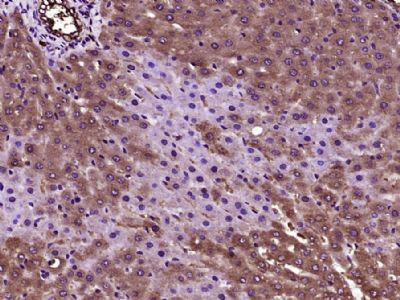Dual-specificity phosphatases (DUSPs) constitute a large heterogeneous subgroup of the type I cysteine-based protein-tyrosine phosphatase superfamily. DUSPs are characterized by their ability to dephosphorylate both tyrosine and serine/threonine residues. They have been implicated as major modulators of critical signaling pathways. DUSP18 contains the consensus DUSP SLCterminal catalytic domain but lacks the N-terminal CH2 domain found in the MKP (mitogen-activated protein kinase phosphatase) class of DUSPs (see MIM 600714) (summary by Patterson et al., 2009 [PubMed 19228121]).[supplied by OMIM, Dec 2009]
Function:
Can dephosphorylate single and diphosphorylated synthetic MAPK peptides, with preference for the phosphotyrosine and diphosphorylated forms over phosphothreonine. In vitro, dephosphorylates p-nitrophenyl phosphate (pNPP).
Subcellular Location:
Cytoplasm. Nucleus.
Tissue Specificity:
Widely expressed with highest levels in liver, brain, ovary and testis.
Similarity:
Belongs to the protein-tyrosine phosphatase family. Non-receptor class dual specificity subfamily.
Contains 1 tyrosine-protein phosphatase domain.
SWISS:
Q8NEJ0
Gene ID:
150290
Database links:
Entrez Gene: 150290 Human
Entrez Gene: 75219 Mouse
Omim: 611446 Human
SwissProt: Q8NEJ0 Human
SwissProt: Q8VE01 Mouse
Unigene: 517544 Human
Unigene: 32588 Mouse
| Picture |
Paraformaldehyde-fixed, paraffin embedded (Rat liver); Antigen retrieval by boiling in sodium citrate buffer (pH6.0) for 15min; Block endogenous peroxidase by 3% hydrogen peroxide for 20 minutes; Blocking buffer (normal goat serum) at 37°C for 30min; Antibody incubation with (DUSP18) Polyclonal Antibody, Unconjugated (SL14453R) at 1:400 overnight at 4°C, followed by operating according to SP Kit(Rabbit) (sp-0023) instructions and DAB staining.
|
|
|
